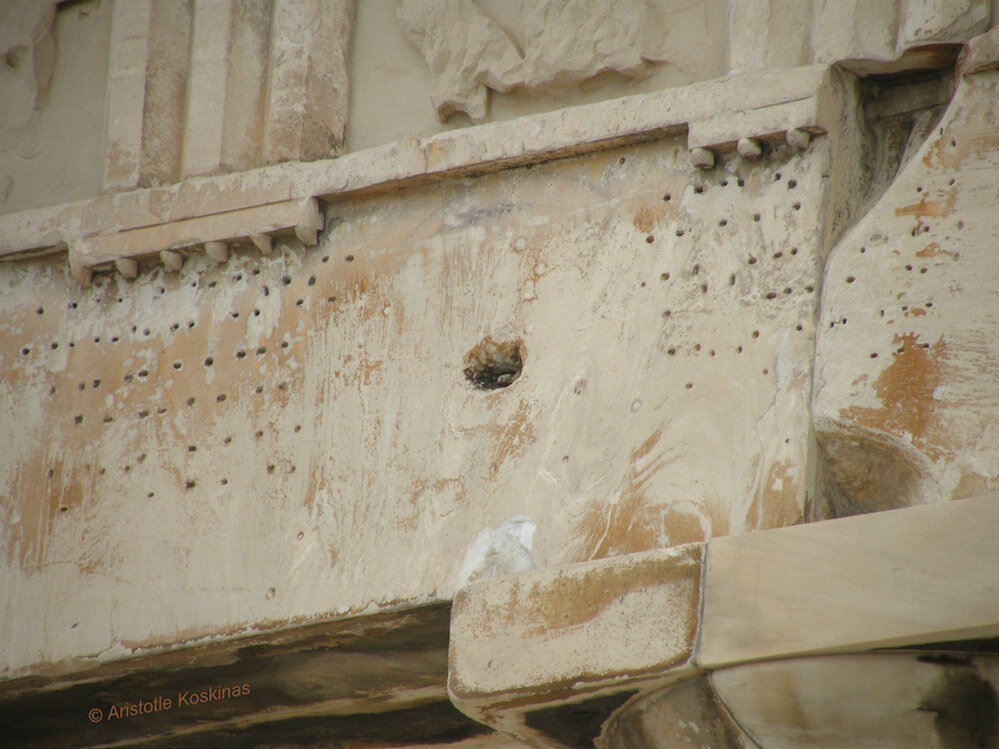In June of 334 BC, Alexander III won a triumphant victory over the Persians at Granicus River. This victory essentially cleared the way for the conquest of the Persian Empire, a conquest that would give him the name Megas and establish a new era.
After this victory, Alexander commissioned a regiment of 25 statues at the Sanctuary of Zeus in Dion, Macedonia, representing the 25 Companions(elite cavalry of the Macedonian army) who fell in this battle.
But he sent another great votive offering to the Acropolis of Athens, a set of 300 suits of armor, as Arrianos mentions, with the votive inscription "Alexander Philip and the Greeks, except the Lacedaemonians, against the barbarians who dwell in Asia". Gilt shields hung on the Parthenon must have been part of this tribute.
This act by Alexander of dedicating arms to a shrine was not unprecedented. The assignment of arms to local and Panhellenic shrines had been a widespread practice since the Archaic period. Commissaries offered either the weapons they brought to battle (such as the helmet Miltiades dedicated to the sanctuary of Zeus at Olympia), or (mainly) weapons left behind by the defeated enemy or taken from them after their death in battle.
The offerings were usually accompanied by an inscription with the origin of the weapon and the name of the person who commissioned it. These weapons were either hung on the walls of the temples or placed as trophies outside the sanctuaries. In the latter case, wooden poles were used on which armor(consisting of chest, helmet, shield, leggings) was placed together with offensive weapons.
The hanging of shields on the walls of temples is documented already from the 5th century. The Spartans had hung a golden shield in the temple of Zeus at Olympia for their victory at Tanagra in 457 BC, while Pausanias reports seeing shields hanging in the temple of Apollo at Delphi, captured by the Athenians as booty from the Persians.
This custom continued in the following centuries, and found imitators even among the Romans. Thus General Mommios gave shields to Olympia after the destruction of Corinth.
The meaning of votive offerings
It is significant that Alexander chose the Acropolis for the allotment of such a rich tribute. This is undeniable proof that Athens still retained its importance, at least as a place of political prominence. In 334 BC, Athens is still the largest naval power in the Aegean and, at least formally, an ally of Alexander (the city took part in the Panhellenic Alliance of Corinth, in which Alexander was a general). A little later Demetrios the Defeater consecrates 12,000 pieces of armor to the same shrine.
The inscription clearly refers to this very panhellenic character of the campaign, since all Greeks except the Spartans, who did not agree to take part in the campaign, are named as contractors. Thus, although Sparta at this time is but a shadow of its former greatness, the Spartans literally shine in their absence. Twenty-three centuries later this was very aptly commented on by Cavafy.
What happened to the votive offerings
According to ancient sources, these votive offerings were lost during the reign of the tyrant Lacharis, who, probably in 295 BC, plundered not only the valuable weapons, but also this Athena freed from gold. This did not help him much - the spread of the news made him known throughout Greece as rich, with the result that (when he was later forced to leave the city to flee from Demetrius the Defeater) he was killed by thieves.
Their traces on the Acropolis
The shields and armor may have been lost forever, but it is possible that a trace of this tribute was left on the Parthenon.
On the eastern façade of the temple, on the entablature, there are 14 rectangular holes in which the limbs are still preserved. These marks indicate the location of 14 shields, 1.25 m in diameter, corresponding to the 14 metopes of the temple. These dimensions are much larger than the usual hoplite shield, which was about 1 m.
On the other sides of the temple there are holes for the suspension of 42 other objects belonging to different phases. If they were also shields, their diameter was much smaller and they were placed directly above the columns. Others claim that gold wreaths were placed there.
Arrian mentions 300 suits of armor, not shields. Do the marks we see today correspond to part of this tribute?
Source: aristotelisguidegr












